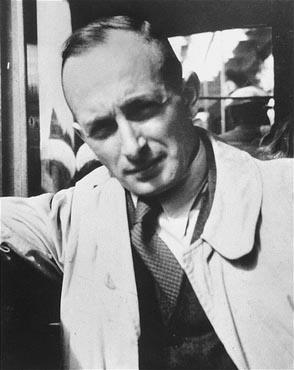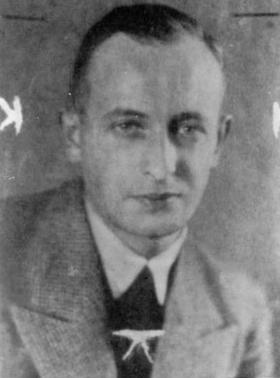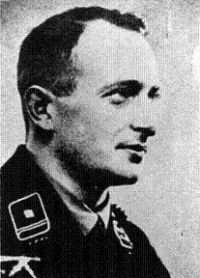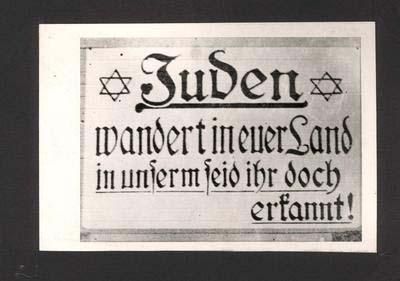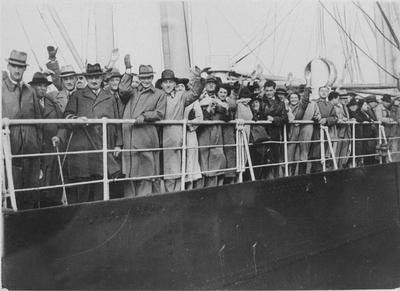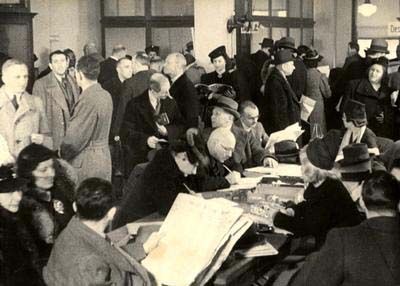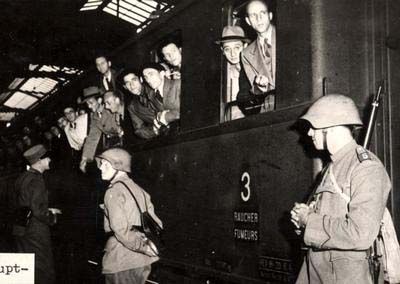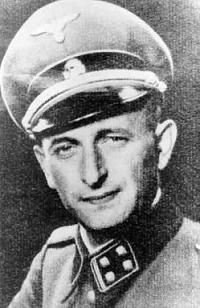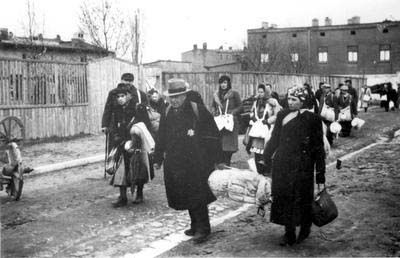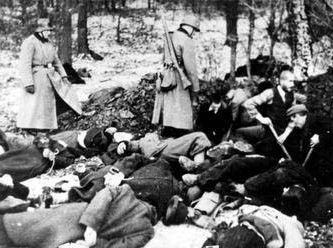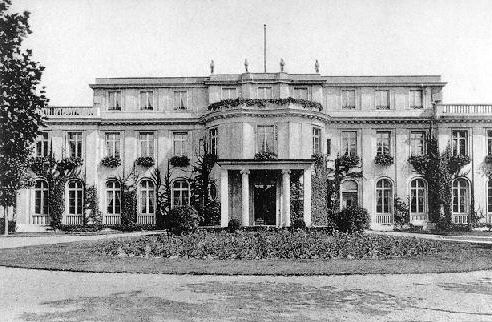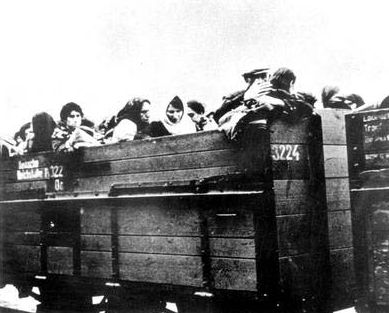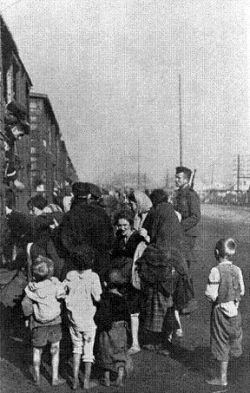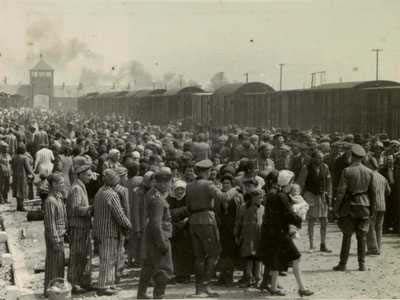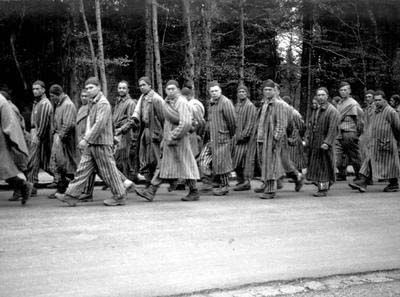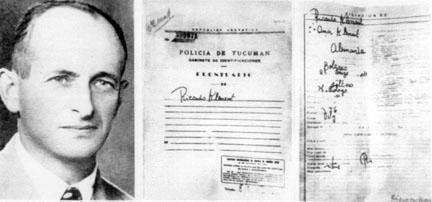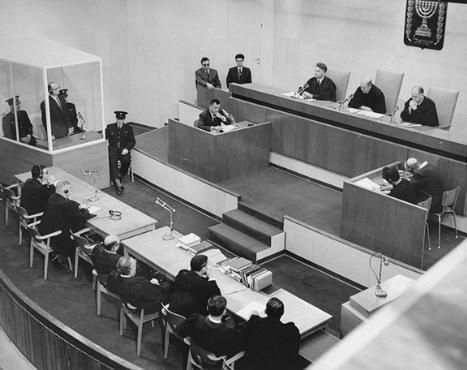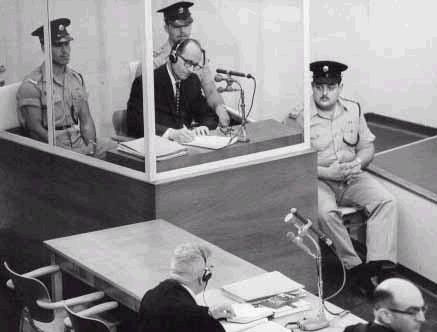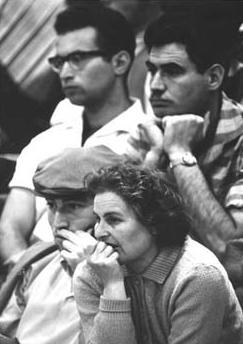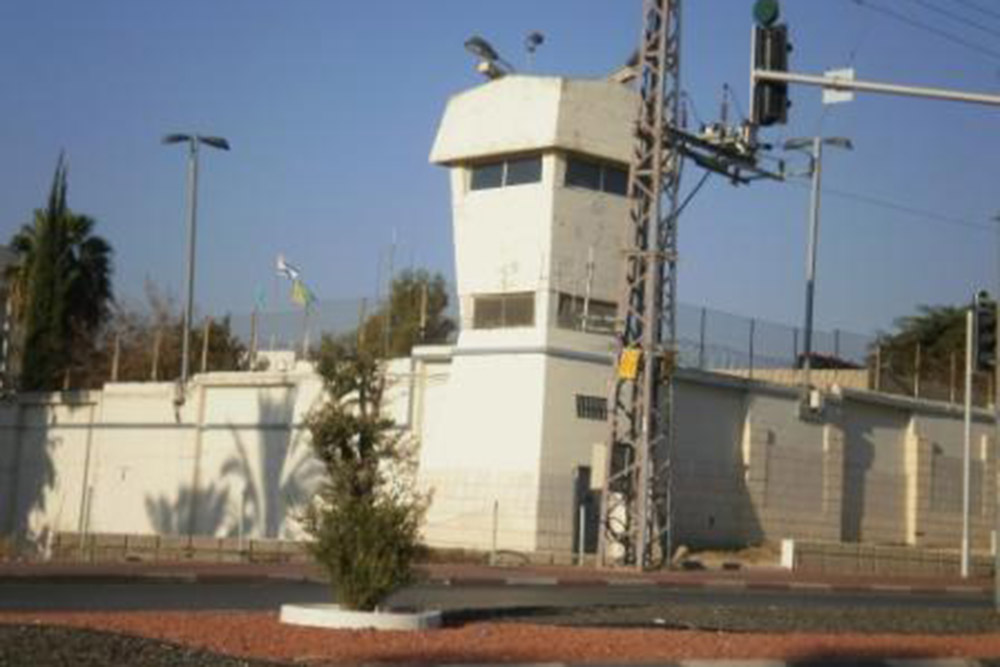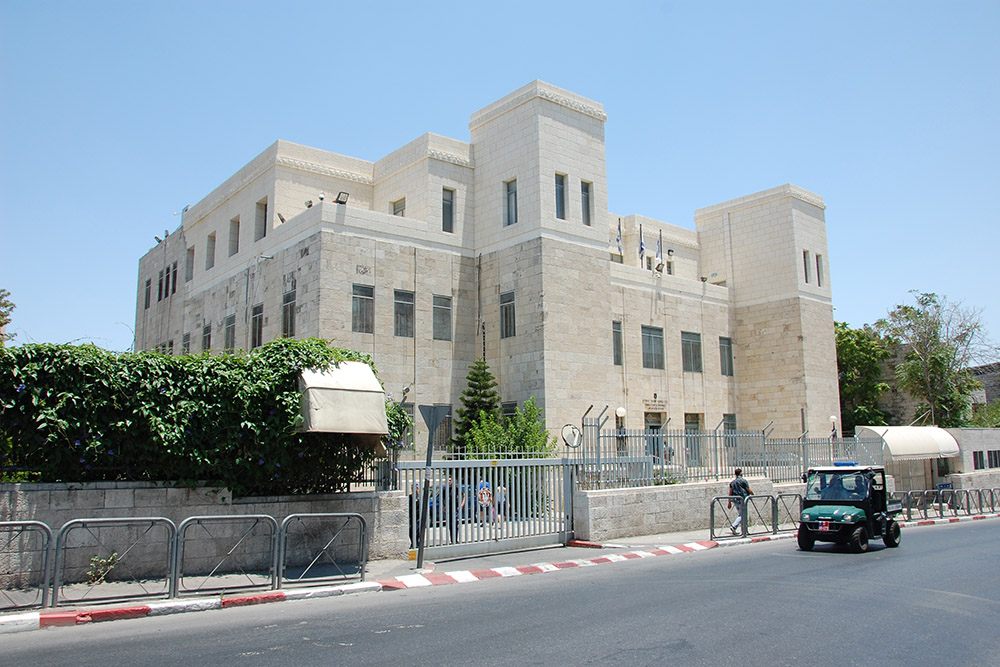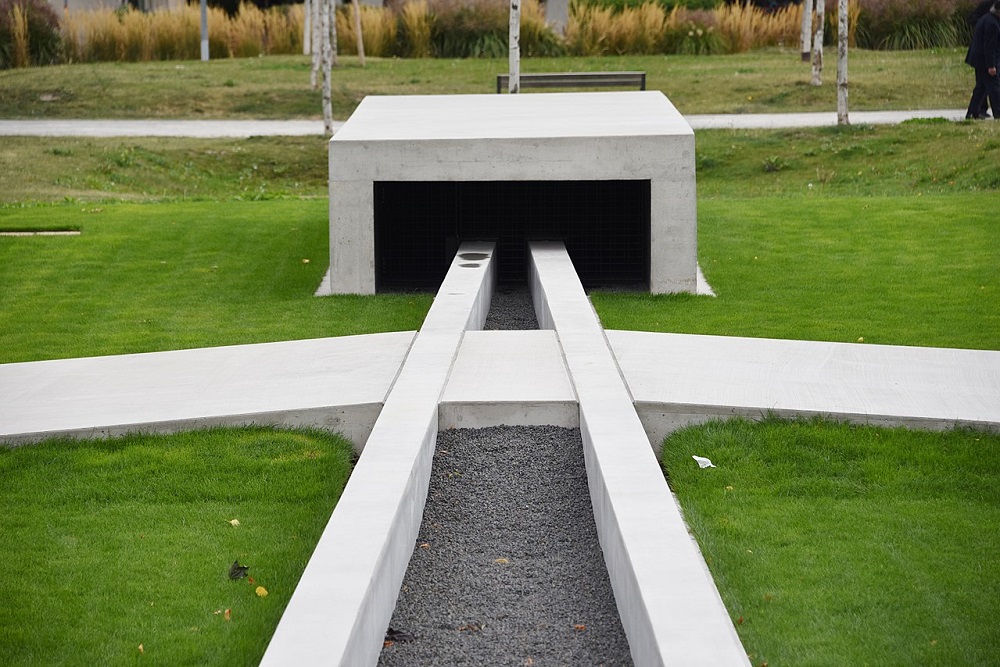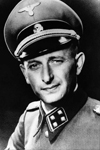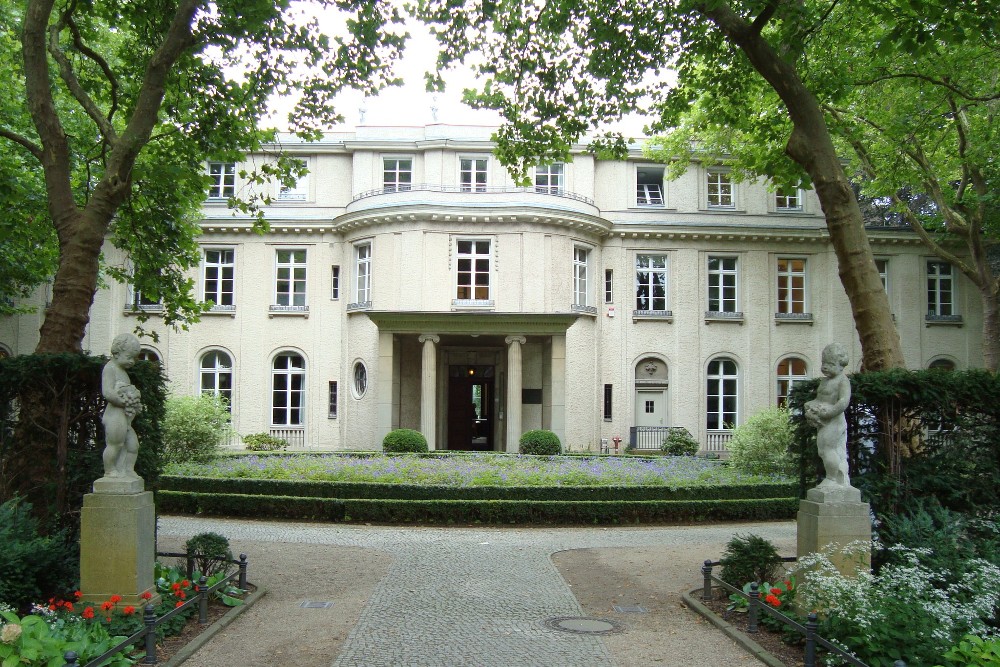Desk assassin of the Third Reich
Introduction
During Hitler’s reign over the Third Reich, some 6 million Jews were killed. This massive process of extermination was carried out by the SS (Schutzstaffel) led by Heinrich Himmler. Himmler Bio Himmler) was assisted by various Nazi officials who co-ordinated the deportation to the extermination camps. Adolf Eichmann was the most important organiser of these deportations. From the very beginning of his Nazi career, Eichmann occupied himself with Jewish matters. When he was put in charge of the Jewish Section of the Gestapo (Secret State Police) within the Reichssicherheitshauptamt (RSHA, Head Office of State Security) he became one of the most important designers of the Holocaust.Before Eichmann got involved in the co-ordination of the deportation to the extermination camps, he occupied himself with the organisation and execution of plans for emigration of Jews within the Third Reich. Before the Einsatzgruppen (mobile death squads) and the extermination camps became operational, Jews were put under severe pressure to leave the Third Reich in their masses. Because the execution of these plans caused many problems, the Germans ultimately reverted to the annihilation of European Jewry.
In this article, Eichmann’s life and Nazi career are described, as well as his post war life, his arrest and his standing trial as a war criminal. In addition, the historic process from emigration to physical annihilation takes a central place in this article; a process in which Eichmann was closely involved.
Definitielijst
- Holocaust
- Term for the destruction of European Jewry by the Nazis. Holokauston is the Greek term for a completely burnt sacrifice.
- Jews
- Middle Eastern people with own religion that lived in Palestine. They distinguished themselves by their strong monotheism and the strict observance of the Law and tradition. During World War 2 the Jewish people were ruthlessly persecuted and annihilated by the German Nazis. . An estimated 6,000,000 Jews were exterminated.
- Nazi
- Abbreviation of a national socialist.
- RSHA
- Reichssicherheitshauptamt. The central information and security service of the Third Reich.
Images
Childhood and the start of a Nazi career
Childhood years
Adolf Eichmann was born March 19th, 1906 in Solingen, a town in the German Rhineland. He was the son of Adolf Karl Eichmann and his wife Maria Eichmann Schefferling. Adolf Karl was accountant and owned a company. In 1914, the Protestant family moved to Linz in Austria where father Eichmann became manager of an enterprise in electrical technique. Maria Eichmann died when her son Adolf was ten years old. His father would soon remarry.In his childhood years, Mischa Sebba, a boy of Jewish decent, was Adolf’s closest friend. Also he seemed to have been bullied in his youth, due to his dark complexion which made him look like a Jew. When Adolf was called "Der kleine Jude"(the little Jew) during his youth, his tormentors did not yet know that he would eventually grow into one of the greatest enemies of the Jewish people in history.
In Linz, Eichmann took a course in civil engineering at the Höheren Bundeslehranstalt für Elektrotechnik, Machinenbau und Hochbau (Federal Academy for Electrotechnics, mechanical engineering, machine and building construction). He quit school however without a diploma. After this study, Eichmann was employed as a miner for a while by the Unterberger Bergbaugesellschaft (Unterberger Mining Company), his father’s company. Subsequently he worked as a salesman for an electrotechnical company, Oberösterreichischer Elektrobau (Upper Austrian Electric installation) and from 1927 to 1933 he worked as agent for the American Vacuum Oil Company in Vienna. His position with this company offered him the possibility to travel.
From 1927 onwards, Eichmann was a member of the Deutsch-Österreichischen Frontkämpferbund (Associaition of German-Austrian frontsoldiers), a nationalistic political movement. In 1931, Eichmann got engaged to Veronika Liebl and he would marry her in March 1935. Before the end of the war, they had three sons: Horst, Klaus and Dieter. After his escape from Europe, they had a fourth son in 1953, named Ricardo Francisco.
In 1932, Adolf and his father were invited to a meeting of the Austrian Nazi party by a friend of the family. This friend was Dr. Ernst Kaltenbrunner (Bio Kaltenbrunner) who later would become chief of the RSHA and so one of Eichmann’s future superiors. April 1st, 1932, Adolf joined the Austrian branch of the N.S.D.A.P. and the Schutzstaffel (SS).
The early years of his Nazi career
When Adolf lost his job in 1933, he asked Kaltenbrunner for help. Kaltenbrunner saw to it that Eichmann was admitted to an SS Brigade, consisting of Austrians. In Bavaria, Germany he attended a fourteen-months military training. In 1934 he worked as an administrator in concentration camp Dachau for a few months under camp commander Theodor Eicke. In this rigidly run camp, which served as an model for concentration camps all over Germany and in the occupied territories, Eichmann gained experience in the running of such a camp.Eichmann did not work for long at Dachau. He was a member of the SD (Sicherheitsdienst or Security Sevice), the intelligence department of the SS, since 1932 and in 1934 he started work in the head office of this organisation in Berlin. Eichmann first worked in the department responsible for gathering information on Free Masonry but on October 1st, 1943, he was made head of Referat II 112 (Referat Juden), the new section of the SD.
Within the Jewish section of the SD, Eichmann set about fanatically learning as much as possible about Jewry. He studied Jewish culture by visiting Jewish quarters, among other things. He investigated Zionism (the Jewish desire to establish their own state in Palestine) and learned Hebrew and Jiddisch. With his knowledge of Jewry, he would present himself as the expert of choice on Jewish matters in the Third Reich.
Definitielijst
- Brigade
- Consisted mostly of two or more regiments. Could operate independently or as part of a division. Sometimes they were part of a corps instead of a division. In theory a brigade consisted of 5,000 to 7,000 men.
- concentration camp
- Closed camp where people are being held captive that are considered to be anti- social, enemies of the state, criminal or unwanted individuals. These groups mostly do not get a fair trial or are condemned to doing time in a camp.
- Nazi
- Abbreviation of a national socialist.
- Rhineland
- German-speaking demilitarized area on the right bank of the Rhine which was occupied by Adolf Hitler in 1936 after World War 1.
- RSHA
- Reichssicherheitshauptamt. The central information and security service of the Third Reich.
- Schutzstaffel (SS)
- The Schutzstaffel commanded by Heinrich Himmler was a very powerful organisation within the Third Reich. The original goal of the SS was to protect Adolf Hitler and other Nazi’s but soon the SS was deployed for several military, security and police tasks. The SS guarded inter alia the concentration camps and manned the Einzatzgruppen. The armed branch of the SS was the Waffen-SS.
- Zionism
- Jewish movement which aims for the return of the Jews to Zion/Sion and the founding of a Jewish state in Palestine
Images
Organiser of forced emigration of Jews
Plans for emigration
As from the founding of Hitler’s party, the N.S.D.A.P., control of Jewry was a very important point on the program. Jews were unwanted in the Third Reich and since Hitler (Bio Hitler) had come to power in 1933, their rights were severely limited. Jews were no longer allowed to use public transport, for example, they were not allowed to have relationships or sexual contacts with Arians or were banned from certain professions. It was however, Hitler’s ultimate goal to expel the Jews from the Third Reich and Eichmann was given the task to investigate where Jews could emigrate to.Eichmann visited Palestine in 1937 but as Great-Britain had the mandate over this territory, his efforts to negotiate with Zionist leaders yielded little success. In the report he drafted about Jewish emigration to Palestine, he also stated that the establishment of a Jewish state would not be in the interest of Germany.
In Germany, Eichmann advocated increasing the pressure on Jews by forcing them to give up their economic activities and leave. In January 1937, Eichmann had suggested in a long memorandum that pogroms (organised and violent attacks on Jews as well as on their properties) were the most successful method to boost Jewish emigration. Increasing this pressure and the use of violence would become the accepted method to drive Jews out of Germany. Soon, Eichmann would establish offices responsible for the forced emigration of Jews. This would take place in Austria that had been annexed by Germany on March 12th, 1938.
Central office for Jewish emigration
When Austria was annexed, the German emigration policy concerning Jews was continued here. On August 26th, 1938, the Zentralstelle für Jüdische Auswanderung (Central Agency for Jewish Emigration) was established in Vienna. Eichmann, meanwhile 32 years of age, was in charge of this government department from the former Rothschild Palace on Prinz Eugenstrasse. At this office Jews were able to buy emigration papers for a fortune. In addition, their possessions were confiscated and extreme high rates of exchange were charged for the foreign currency the emigrants needed.In order to get the emigration of Jews under way, Jews were being humiliated and the use of physical violence against them was no longer the exception. Just like in Germany, anti-Jew laws were being introduced, resulting in 8.000 Jewish enterprises being Arisiert (Arianized) and 30.000 Jews fired. In addition, Jewish physicians and lawyers were no longer allowed to practice and 12.000 families were evicted from their homes. Many Jews saw no perspective in their future and committed suicide. Within the course of a few weeks, 98.000 Jews, almost half the Jewish population of the country, left Austria. All those departing Jews left their money and possessions behind and so the emigration office became an enterprise yielding millions for the Third Reich.
Eichmann’s office was the model for the entire emigration policy of the Third Reich. Reinhard Heydrich (Bio Heydrich), chief of the SD and the future chief of the RSHA was highly satisfied with this very efficient way to drive the Jews out. Heydrich hated chaos and the bureaucratic Zentralstelle was the exact opposite. On January 24th, 1939, Göring (Bio Göring) ordered Heydrich to set up an office in Berlin, similar to that of Eichmann’s emigration office. Heinrich Müller, future chief of the Gestapo, was put in charge of this office. Under Müller’s direction 40.000 Jews were evicted from Germany in 1938 and 78.000 the next year. On July 26th, 1939, a Zentralstelle was set up in Prague, also under Eichmann’s direction. In October 1939, these Zentralstelle were combined and renamed Reichszentrale für Jüdische Auswanderung.
Head Office of State Security
In December 1939, Eichmann was appointed chief of Referat IV B 4 of the RSHA (Reichssicherungshauptamt). This office was responsible for Räumungsangelegenheiten (Evictions) and Jüdische Auswanderung (Jewish Emigration). As chief of this section, Eichmann obtained an important function within the Nazi terror organisation. He co-operated closely with Reichsführer-SS Himmler and the chief of the RSHA Reynhard Heydrich.Removal of the Jews from the Third Reich was still mainly focused on forced emigration of the Jews. As Germany occupied a large part of Poland in September 1939, the number of Jews in the Third Reich increased. Eichmann drafted two separate plans for emigration, aimed at the removal of Jews from the ever expanding Third Reich. These were the Plan Madagascar and the Plan Lublin.
The Plan Madagascar
This plan was aimed at deporting Jews from Europe to Madagascar, an island under French rule off the southeast coast of Africa. It was no novel plan because it had already been suggested after the First World War by British, Dutch and Polish anti-Semites. In 1937, the Polish government dispatched a committee to Madagascar to look into the possibilities and Eichmann did the same in 1938. Only in 1940, as Hitler occupied part of France and the rest of the country was ruled by the Vichy government which collaborated with the Nazis, this plan came under the attention of high ranking Nazis. The plan was never to be carried out however because the non co-operative Vichy government did not want to give up its colony. Moreover, the British Navy enjoyed supremacy at sea which would thwart the execution of the plan.The Plans Nisko and Lublin
These plans were developed after Germany had invaded Poland on September 1st, 1939 and unleashed the Second World War. According to the agreement between the Nazis and the Soviet Union of August 1939, Poland was divided between the two powers. Germany annexed part of western Poland which was inhabited by some 600.000 Jews and also ruled the General Government in central Poland where 1.5 million Jews resided. The two plans, developed by Eichmann and his SS colleague Franz Stahlecker were aimed at the establishment of a Jewish state under German rule in the region Lublin in the General Government. Jews from all over the Third Reich were to be deported to this Jewish reservation via the Nisko transit camp.The Nisko and Lublin plans were soon aborted owing to technical problems. "Technical problems" probably meant that no work could be found for the ethnic Germans who were to replace the Jews in Poland. The plan was also abandoned because Hitler was no longer interested in a Jewish reservation. Another, final, solution had to be found for the Jewish question. As it was, this plan was the prototype for the mass deportations of Jews in the coming years of the war. The General Government remained the assembly area for deported European Jews but they were not allowed to live in their own, German ruled state. They were housed in ghettos and labor camps where many died from the bad living conditions, starvation and maltreatment.
Definitielijst
- First World War
- Took place from 1914 till 1918 and is also named The Great War. The conflict started because of increased nationalism, militarism and neo-colonialism in Europe. Two alliances battled one another during the 4-year war, which after a dynamic start, resulted into static trench warfare. The belligerents were the Triple Alliance (consisting of Great-Britain, France, and Russia; later enlarged by Italy and the USA, amongst others) on the one hand and the Central Powers (consisting of Germany, Austria-Hungary, Bulgaria and the Ottoman empire) on the other hand. The war was characterized by the huge number of casualties and the use of many new weapons (flamethrowers, aircraft, poison gas, tanks). The war ended in 1918 when Germany and its allies surrendered unconditionally.
- Jews
- Middle Eastern people with own religion that lived in Palestine. They distinguished themselves by their strong monotheism and the strict observance of the Law and tradition. During World War 2 the Jewish people were ruthlessly persecuted and annihilated by the German Nazis. . An estimated 6,000,000 Jews were exterminated.
- Nazi
- Abbreviation of a national socialist.
- RSHA
- Reichssicherheitshauptamt. The central information and security service of the Third Reich.
- Soviet Union
- Soviet Russia, alternative name for the USSR.
- Vichy government
- Government in the unoccupied part of France, seated in Vichy. This government collaborated with the Germans. In 1943 France was completely occupied by Germany.
Images
Run up to the Final Solution
At the end of 1940, a considerable part of Europe had been conquered by Nazi-Germany. As emigration was no longer applied as a means to solve the Jewish question, Eichmann’s Referat within the RSHA was from then on responsible for Jewish affairs and Evictions, in stead of Evictions and Jewish Emigration. Due to a reorganisation, this department was moved to Referat IV B 4. With this office, Eichmann exercised control over all Jews within the Third Reich and he despatched representatives like Alois Brunner, Theodor Dannecker, Dieter Wisliceny and Rolf Günther to the various governments to act as adviser on Jewish affairs. Their task was to promote anti-Jewish policy. His representatives were active in all countries dominated by the Nazis, excepting Scandinavia and the terrritories where the Einsatzgruppen (Special action groups, see Einsatzgruppen Art.) were active.
In the spring of 1941, Special action groups were established in order to eliminate elements hostile to the state in the rear of the German troops who invaded the Soviet Union on June 22nd, 1941. Before extermination camps were equipped to murder Jews, these groups had already murdered more than a million Jews. Executing Jews and clearing away the corpses entailed operational problems. This method was not suitable for efficiently exterminating all European Jews within a short period, which was what Hitler really wanted. So, a definite solution had to be found: the Endlösung.
July 16th, 1941, SS-Sturmbannführer Rolf-Heinz Höppner, chief of the SD in Poznan, Poland wrote to Eichmann: "This winter, there is the danger that not all Jews cannot be fed any longer. Serious consideration should be given to the question whether it would not be the most humane solution to kill those Jews who are not able to work with some sort of fast acting substance. That would be more convenient than letting them starve to death" An increasing number of Nazis was thinking about eliminating the Jews, as already done by the Special action groups and by "natural decline" in the labor and concentration camps and in the ghettos.
July 15th, Heinrich Himmler paid a visit to Hitler in his Wolfsschanze (Wolf’s lair, Hitler’s HQ) in eastern Prussia. Nothing this pair discussed was put down in writing but presumably they had been discussing the fate of the Jews. Eichmann asserted later he was called to Heydrich’s office shortly afterwards. Heydrich would have told Eichmann: "The Führer has ordered to eliminate all Jews" Eichmann later said about this conversation during his interrogations that Heydrich: "contrary to his habit, kept silent for a long time, as if he wanted to see what effect his words had on me". It took a while before Heydrich’s words got through to Eichmann but he stated: "then I understood and said nothing more because there was nothing more to be said". Many historians nowadays contradict Eichmann’s statement and assume that the decision to exterminate all European Jews was only taken in December 1941.
Whatever it was, Eichmann had to draft a document of authorisation which Heydrich presented to Hermann Göring who, as chairman of the Reichsverteidigungsrat was formally still in charge of the policy concerning Jews. The document reads as follows: "In addition to the task, which has been alloted to you on January 24th, 1939, to solve the Jewish question in the best way possible under the present conditions by emigration and evacuation, I hereby order you to make all necessary preparations concerning the administrative, factual and material matters for the final solution of the Jewish question within the German sphere of influence in Europe".
And it goes on: "Furthermore, I order you to send me at short notice an all-encompassing plan concerning the administrative, factual and material matters required for the realisation of the desired Endlösung der Judenfrage (Final solution of the Jewish question)".
Göring signed this document and meanwhile, Himmler had already started on the execution of his plans. He informed the camp commander of Auschwitz, Rudolf Höss, that his camp had been designated to carry out the final solution and that Eichmann would shortly visit the camp to give more details. A few days later, Eichmann paid a visit to Auschwitz and discussed the details of the operation with Höss. They agreed that gassing was the only practical method. A second camp, Auschwitz-Birkenau was to be built with gas chambers to hold 800 persons.
Gassing in extermination camps had to be carried out with carbonmonoxide which was already in use as a means for mass murder. So called gas vans had been in use since 1940 to murder the disabled. An airtight compartment on these trucks was fitted with pipes through which the exhaust fumes were blown in. These trucks were also deployed in Chelmno, the first operational extermination camp. Here Jews were already gassed even before the final solution had been discussed at the Wannsee conference.
In the ghetto in Lodz (at the time named Litzmannstadt by the Germans) in Poland, hundreds of thousands of Jews were packed together. The number of inhabitants had long exceeded its capacity. The Stategovernor of Warthegau, SS-Gruppenführer Arthur Greiser, wanted to get rid of this problem and asked Himmler for help. Himmnler put Heydrich on the case who in turn asked Herbert Lange for his help. Herbert Lange was the commander of Sonderkommando Lange, a unit which had been killing disabled persons since early 1940 in connection with the Tiergartenstrasse 4 (T 4) program of euthanesia. Lange already had experience with the use of gas vans and had to develop their use further as a method for organised murder in Chelmno. Gassing of prisoners was further investigated, also on advise by the chief of the medical branch of the SS, Dr. Ernst von Grawitz. He said poison gas was the most effective and humane way to kill people.
The first group of prisoners arrived in Chelmno on December 7th, 1941 and extermination was begun the next day. The prisoners were told they were to wash themselves but instead of that, they were herded into gas trucks. When the truck was loaded to capacity, the doors were closed and the engine was started. The trucks were driven to a clearing in the woods. When the doors were opened again, the victims should have died. A special clearing squad buried the bodies in a mass grave.
After about 15 minutes, the victims should have died of carbonmonoxide poisoning but Eichmann himself, who had meanwhile been promoted to SS-Obersturmbannführer on November 9th, 1941, discovered that this calculation was not always correct. Ordered by Gestapo chief Heinrich Müller, Eichmann inspected this method of gassing but he was apalled by the poor functioning of it. After 15 minutes, some victims were still alive. In addition, the unloading of the trucks and the burying of the corpses was a depressing task and the vans often broke down on the all but impassable dirt roads. A better method had to be found. Instead of gassing of victims in vans with a capacity of 40 to 50 people, gas chambers of a larger capacity were erected. In the future, all extermination camps would be equipped with gas chambers in which victims were gassed with carbonmonoxide.
A far more efficient method was invented by Rudolf Höss’ deputy, SS-Hauptsturmführer Karl Fritsch. He came up with the idea to use the poison gas Zyklon B instead of carbonmonoxide. This substance was introduced as the standard in the gas chambers of the extermination camps of Auschwitz-Birkenau and Majdanek only at the end of 1942. In some concentration camps, Zyklon B was also used to kill victims. At the end of 1941 however, the majority of Jews was still being killed by shooting or in gas vans. The mass gassing of Jews only got under way in 1942, after the conference at the Wannsee.
Definitielijst
- Auschwitz-Birkenau
- The largest German concentration camp, located in Poland. Liberated on 26 January 1945. An estimated 1,1 million people, mainly Jews, perished here mainly in the gas chambers.
- Endlösung
- Euphemistic term for the final solution the Nazis had in store for the “Jewish problem”. Eventually the Endlösung would get the form of annihilating the entire Jewish people in extermination camps.
- Führer
- German word for leader. During his reign of power Adolf Hitler was Führer of Nazi Germany.
- ghetto
- Part of a town separated from the outside world to segregate Jewish population. The establishment of ghettos was intended to exclude the Jews from daily life and from the rest of the people. From these ghettos it was also easier to deport the Jews to the concentration and extermination camps. Also known as “Judenviertel” or Jewish quarter.
- Jews
- Middle Eastern people with own religion that lived in Palestine. They distinguished themselves by their strong monotheism and the strict observance of the Law and tradition. During World War 2 the Jewish people were ruthlessly persecuted and annihilated by the German Nazis. . An estimated 6,000,000 Jews were exterminated.
- Nazi
- Abbreviation of a national socialist.
- RSHA
- Reichssicherheitshauptamt. The central information and security service of the Third Reich.
- Soviet Union
- Soviet Russia, alternative name for the USSR.
- Wannsee conference
- Conference at the Wannsee on 20 January 1942. The Nazi’s made final agreements about the extermination of Jews in Europe, the Final Solution (Ëndlösung).
- Wolfsschanze
- Headquarters of Adolf Hitler in East Prussia.
Images
Organiser of the Final Solution
The Wannsee conference
January 20th, 1942, a secret meeting was held in a mansion on the shore of the Wannsee (Lake Wann), attended by 14 high ranking Nazis who were al involved in the Jewish question. These senior officials were state secretaries and representatives of the SS. The meeting was chaired by Heydrich, Eichmann provided certain data and took notes. At this meeting it was discussed in which way the mass extermination of the Jews should be organised and carried out further. Before the start of the meeting, 40.000 Jews and Gypsies had already been murdered in the extermination camp Chelmno. As from the start of Operation Barbarossa, the Special action groups also had killed many hundreds of thousands of Jews. It is therefore obvious that prior to the start of this meeting, the assembly line murder had already begun and that it had already been decided upon to remove and kill the Jews. The only question was how to continue this mass extermination even quicker and more efficiently.Heydrich opened the meeting by summarizing the applied policy concerning the Jews and finally came to the main subject of the meeting: the removal of no less than 11 million Jews from Europe. According to Heydrich: "Europe should be combed from east to west". These 11 million Jews were to be deported to the east and put to work there, whereby a great many would fall off by "natural decline". Later, Eichmann explained this "natural decline" to the Israeli captain Avner Less during an interrogation in Israel after his arrest: "That is a completely natural death, a heart attack or pneumonia. If I were to die at this very moment, then that is "natural decline".
In his minutes Eichmann described what would happen to the Jews who survived the forced labor. He wrote: "The eventual remaining number should, as it undoubtedly consists of the ones with the highest resistance, be treated accordingly. On release, they should be considered as the core of a new Jewish build up, representing a natural selection". (See the experience in history).
Captain Ayner Less asked Eichmann during his interrogation what he meant by "treated accordingly", at which Eichmann replied, stuttering: "That is ……..that is……. This case originates from Himmler. Natural selection ……. that is, ……that was his favourite topic" Eichmann continued with: "They were killed, killed! That is for sure!".
The minutes of the meeting did not include statements about the killing of Jews. Eichmann, who took the notes, toned down the overt statements at the conference table to more veiled terms. Eichmann stated later that discussion about killing, eliminating and extermination of Jews did take place.
After the end of the meeting, a cosy engagement took place between Heydrich, Müller and Eichmann. Later he stated about this: "I can remember Heydrich, Müller and me sitting cosily by the stove and that I saw Heydrich smoke for the first time and I thought to myself: Heydrich smokes today. I had never seen him do that. He drinks brandy and that I hadn’t see him do either for years…. We sat together as friends. Not to talk about work but to rest after hours of hard work". These gentlemen had just discussed mass murder during a meeting. After the Wannsee conference, mass murder of the Jewish population was taken up in extermination camps with lightning speed.
The final solution
As discussed during the Wannsee conference, Jews from the entire Third Reich were deported to the extermination camps where they were murdered. Chelmno was in December 1942 already operational as an extermination camp. In the spring of 1942 Belzec and Auschwitz-Birkenau followed in March, Sobibor in May and Treblinka in July. On arrival, the victims were first subjected to a selection. Those capable of work were forced to do extremely heavy work under horrendous conditions so that they too would perish soon. People unable to work had to undress and were told they were to take a shower for delousing. Their clothing and meager possessions were taken away from them and they were herded into a shower room. Instead of taking a shower however, they were gassed. The first test with Zyklon B had been run on September 3rd ,1941 in Auschwitz were it became the standard substance for gassing. In Chelmno, Belzec, Sobibor and Treblinka, victims continued being gassed with carbonmonoxide. After the gassing, special Sonderkommandos, made up of inmates, extricated the bodies from the shower rooms and took them to the ovens to be cremated.Table showing the numbers of victims (about 90% of them Jews) who were murdered in the extermination camps.
| Camp | Operational | Victims |
| Chelmno | December 1941 - summer 1944 | 320.000 |
| Auschwitz Birkenau | March 1942 - November 1944 | 1.000.000 |
| Belzec | March 1942 - December 1942 | 436.000 |
| Sobibor | April 1942 - October 1943 | 250.000 |
| Treblinka | July 1942 - August 1943 | 870.000 |
| Majdanek | unknown | 360.000 |
Remarks:
- 1. Numbers and data taken from: Encyclopedie van de Holocaust, R. Rozett and S. Spector.
2. As selections also took place in Majdanek and the majority of deportees were exterminated right away, some historians consider this concentration camp an extermination camp. The date on which Majdanek became operational as extermination camp is therefore difficult to ascertain. Majdanek as a concentration camp was in operation from October 1941 to July 1944.
The central direction of the deportation was in the hands of Eichmann. He was still in charge of the Jewish Section within the RSHA which was headed by Kaltenbrunner after Heydrich’s death on June 4th, 1942. Heydrich had fallen victim to an assassination attempt by Czech resistance fighters. Eichmann was shocked by the attempt on his boss and his death a few days later. When he heard the news he was, in his own words, astonished and dazed. Supervised by Kaltenbrunner, Eichmann continued his work notwithstanding. Heydrich’s death could not put a stop to the extensive extermination of the Jewish population.
From 1942 onwards, Eichmann paid numerous visits to extermination camps to supervise their efficiency and progress. He displayed a special interest for Auschwitz. He visited this camp frequently to evaluate the extermination progress with camp commander Höss. Here he also witnessed several gassings. In addition to his responsibility for the logistics of the Endlösung, Eichmann was also responsible for the ghetto in Theresienstadt. A total of 140.000 Jews was deported to this ghetto of which 33.000 died there, 88.000 were deported to extermination camps and 19.000 survived the ghetto or were taken to Switzerland or Sweden.
Definitielijst
- Auschwitz-Birkenau
- The largest German concentration camp, located in Poland. Liberated on 26 January 1945. An estimated 1,1 million people, mainly Jews, perished here mainly in the gas chambers.
- concentration camp
- Closed camp where people are being held captive that are considered to be anti- social, enemies of the state, criminal or unwanted individuals. These groups mostly do not get a fair trial or are condemned to doing time in a camp.
- Endlösung
- Euphemistic term for the final solution the Nazis had in store for the “Jewish problem”. Eventually the Endlösung would get the form of annihilating the entire Jewish people in extermination camps.
- ghetto
- Part of a town separated from the outside world to segregate Jewish population. The establishment of ghettos was intended to exclude the Jews from daily life and from the rest of the people. From these ghettos it was also easier to deport the Jews to the concentration and extermination camps. Also known as “Judenviertel” or Jewish quarter.
- Holocaust
- Term for the destruction of European Jewry by the Nazis. Holokauston is the Greek term for a completely burnt sacrifice.
- Jews
- Middle Eastern people with own religion that lived in Palestine. They distinguished themselves by their strong monotheism and the strict observance of the Law and tradition. During World War 2 the Jewish people were ruthlessly persecuted and annihilated by the German Nazis. . An estimated 6,000,000 Jews were exterminated.
- Majdanek
- Concentration camp nearby the Polish city of Lublin. Originally a POW camp. From 1942 an extermination camp.
- resistance
- Resistance against the enemy. Often also with armed resources.
- RSHA
- Reichssicherheitshauptamt. The central information and security service of the Third Reich.
- Theresienstadt
- City in the Czech Republic. Here the Nazis established a model concentration camp.
- Wannsee conference
- Conference at the Wannsee on 20 January 1942. The Nazi’s made final agreements about the extermination of Jews in Europe, the Final Solution (Ëndlösung).
Images
The fall of the Third Reich
The fall
After the numerous German victories and the steady conquests, from 1943 onwards an obvious turn of events in the progress of the war was noticeable. Germany had lost the battle for Stalingrad in February 1943 and the entire German eastern front was slowly pushed backwards. The Allies enjoyed increasing successes. In May 1943, German and Italian troops surrendered in North-Africa and in July 1943, Allied troops invaded Sicily, opening a new front. In September, the former Axis power Italy entered into an armistice with the Western Allies. In June 1944, Allied troops landed in Normandy from where they steadily advanced towards Germany.Despite the continuing setbacks and defeats by the Germans, the murdering in the extermination camps continued as usual. Despite the enormous shortage of manpower, Jews and other undesired elements were not employed as laborers. Up to the fall of the Third Reich, Eichmann remained resposible for the deportation of Jews to the extermination camps. When Hungary tried to break off the alliance with Germany, the German army invaded the country on March 19th, 1944. Eichmann unleashed one last gigantic cleansing action.
Holocaust in Hungary
On November 20th, 1940, Hungary had joined Germany, Italy and Japan, the so called Axis. Hungary declared war on the Soviet Union on June 29th, 1941 and fought on the side of the Germany. After many defeats, claiming tens of thousands Hungarian lives, the regent of Hungary, Miklos Horthy, tried to leave the alliance with Germany. Hitler did not appreciate this at all and German troops attacked Hungary in March 1944. In Hungary, Jews had been left relatively undisturbed, apart from discriminatory anti-Jewish laws and sporadic deportations. This however changed after the invasion. Under personal direction from Eichmann, Special action groups immediately set about capturing and deporting Jews. From April 29th to early July, 437.402 Hungarian Jews were deported to the extermination camps. Neither gas chambers nor crematoria could handle the flood of 12.000 persons per day and camp commander Höss was forced to temporarily apply the old method of the Special action groups. Jews were once more killed by shooting and subsequently cremated and buried in mass graves.Erasing the traces
In the final period of the Holocaust more and more concentration and extermination camps were being shut down. The process of extermination was accelerated and many inmates were transferred to camps outside the danger zone. During these death marches many inmates perished. An estimated 200.000 Jews went along on these marches and 80.000 of them died on German soil just before the end of the war. All these actions were aimed at erasing all traces of the mass extermination. In this way, this evidence could not be used against the perpetrators of the Holocaust in case of the imminent victory by the Allies. These actions of cleansing and erasion, which were to Eichmann’s advantage, were not successful however as the Allied advances on the Western as well on the Eastern front progressed too fast. Eichmann had to see to it fast to stay out of Allied hands himself.His successful escape
After Eichmann had ended his activities for the Jewish Section of the RSHA, he left for the Altaussee in Austria on orders from Kaltenbrunner in order to organize the last resistance against the Allies. In this so called Alpenfestung (Alpine fortress), fanatical SS men were to fight a guerilla war against the Allies. This desperate attempt, which could have turned into a prolonged and bloody battle, came to nothing however. Eichmann probably was one of the few who believed in this Alpenfestung. According to Nazi hunter Simon Wiesenthal, who tracked down Eichmann many years later, he had another reason to flee to this Alpenfestung. Wiesenthal argued that Eichmann had fled to Austria in order to hide, together with his accomplishes, 22 cases of valuables stolen from Jews. These valuables included, among other things, gold wedding rings, fillings and jewelry. The value of this Eichmann gold was valued in 1955 by the public prosecutor’s office in Vienna at 8 million dollars. Up until today however, this treasure has never been found. Whether this treasure really exists or not is not proven either.After Germany had surrendered in May 1945, Eichmann was arrested and interned in an American detention camp. The Americans were unaware however that they had one of the most important organisers of the Holocaust in their hands because he had adopted a false name: Otto Eckmann. He subsequently succeeded in escaping and lived in Germany for a few years. Here it probably became too dangerous for him and in July 1950 he fled to South-America via the abby route. In his own words he was assisted by a Franciscan monk in Genoa who give him a refugee pass in the name of Ricardo Klement and a visum for Argentina. His Red Cross card was probably signed by the Hungarian priest Edoardo Dömöter of the San Antonio parish in Genoa. He allegedly also received help from SS-Hauptsturmführer Horst Carlos Fuldner, a German born Argentinian who worked for the Foreign Section of the SD. Fuldner also brought other Nazis, such as Josef Mengele (Bio Mengele), the camp physician of Auschwitz; Hans Ulrich Rudel, the most decorated Luftwaffe pilot and Adolf Galland, General of the Luftwaffe over to Argentina. The Argentinian president, Juan Péron knew that his country was being used as a safe haven for Nazis. That was no problem for him since he sympathised with the Nazi regime. In 1952, Eichmann had his wife and their three sons also come to Argentina from Austria. Their fourth son was born in 1953.
Definitielijst
- Alpenfestung
- Fortification in the Alps. The first development spotted by the Americans in 1944. The Americans feared a stronghold in the Alps as a last resort of the Nazis. The plan was covered in mystery. On the one hand the Alpenfestung might be the last SS stronghold which could lead to defeat of the Allied forces. Enormous arms depots were built and Nazi elite troops would be able to hide everywhere in the Alps and cause death and despair behind enemy lines, sometimes even in allied uniforms. This terrifying development was fed by German propaganda trying to lure the American forces towards the Alps and away from the Rhine. Although the British warned against this, the Americans decided to divide their forces and had them advance towards Berlin as well as the south. The Alpenfestung turned out, however, to be nothing but a spectre.
- Holocaust
- Term for the destruction of European Jewry by the Nazis. Holokauston is the Greek term for a completely burnt sacrifice.
- invasion
- Armed incursion.
- Jews
- Middle Eastern people with own religion that lived in Palestine. They distinguished themselves by their strong monotheism and the strict observance of the Law and tradition. During World War 2 the Jewish people were ruthlessly persecuted and annihilated by the German Nazis. . An estimated 6,000,000 Jews were exterminated.
- Luftwaffe
- German air force.
- Nazi
- Abbreviation of a national socialist.
- resistance
- Resistance against the enemy. Often also with armed resources.
- RSHA
- Reichssicherheitshauptamt. The central information and security service of the Third Reich.
- Soviet Union
- Soviet Russia, alternative name for the USSR.
Images
Arrested and sentenced
Arrest
Up until 1960, Eichmann and his family lived safely and undisturbed in Argentina. Eichmann was employed for quite some time as head of a sub department of the German car manufacturer Daimler-Benz. His carefree life came to a sudden end when the German attorney general Fritz Bauer was informed about the location of Eichmann by a former concentration camp inmate who lived in Argentina and contacted the Mossad in secret.On May 11th, 1960 when he returned home from work by bus, Eichmann was arrested by Israeli agents of the Mossad (Israeli secret service). Eichmann offered no resistance during his arrest, was rendered unconscious by the agents and subsequently smuggled out of the country. Israël had not applied for extradition to the Argentinian government so his arrest was in fact illegal. Argentina filed a complaint with the United Nations but this body did not take action and backed Eichmann’s trial in Israël. After 15 years, one of the most important desk assassins of Hitler’s Reich had finally been arrested. He could now be punished for the crimes he had committed.
The Eichmann trial
The trial against Eichmann began on April 10th, 1961. It took place in the district courthouse of Jeruzalem. The sessions were chaired by three judges, namely Supreme Court Judge Moshe Landau (chief judge during the trial), the president of the district court of Jerualem Benjamin Halevi and finally the judge of the district court of Tel Aviv Yitschak Raveh. Chief prosecutor was Israël’s Attorney General, Gideon Hausner. Dr. Robert Servatius, a German lawyer who had defended Nazis before during the Nuremberg trial, defended Eichmann. Eichmann stood trial pursuant to the 1950 Law on Punishment of Nazis and Nazi collaborators. He was indicted on 15 counts, including:- Crimes against the Jewish population,
crimes against humanity,
war crimes,
membership of the SS, SD and Gestapo (organisations that had been declared criminal during the Nuremberg Trial) and
crimes against Poles, Slovenians, Gypsies and Czechs
The chief prosecutor opened the proceedings with a summary of the Holocaust. He called 112 witnesses and in addition presented 1.600 documents. The documents contained much incriminating material and various papers had been signed by Eichmann. Thanks to these witnesses and the documents, it could be proved that Eichmann had been head of the Jewish Section of the Gestapo office for Jewish affairs within the RSHA. It was already known that the goal of this office had been the extermination of European Jewry. The facts were therefore of great disadvantage to the defendant.
Eichmann’s defense did not contest the facts of the prosecutor, nor the documents. Eichmann’s lawyer, Dr. Robert Servatius, decided to focus mainly on the legality of the trial. According to the defense, the trial was not legal for various reasons. First, Servatius wanted to show that the Jewish Israeli judges were prejudiced and therefore the trial against Eichmann could not be fair. Furthermore, in his view the trial was not legal as the defendant had been kidnapped and taken to Israël illegally. Servatius also questioned the legality of the trial taking place in Israel, because Eichmann had committed his crimes elsewhere and moreover, the country did not even exist at the time of the Second World War. Finally, according to the defense, the trial was held pursuant to an illegal law (ex post facto) because it had been introduced right after the end of the Holocaust.
The judges overruled all objections and Eichmann pleaded: "Ich erkläre mich im Sinne der Anklage unschuldig" (not guilty on all counts of the indictment). According to the defense, Eichmann had not acted on his own free will but only obeyed Hitler’s orders. This argument was also rejected by the judges. Eichmann was found guilty on all counts and was considered the key figure in the Endlösung. On December 15th, 1961, he was sentenced to death. Eichmann appealed to the Israeli Supreme Court but the verdict was maintained. He made a last attempt to evade the death penalty by lodging an appeal for clemency with the president of Israel, Itschak-Ben-Zvi but his appeal was rejected. There was no way Eichmann could evade the death penalty.
In the night of May 31st, - June 1st, 1962, Eichmann was hanged in Ramleh prison. His corpse was cremated and the ashes dispersed at sea, outside Israeli territorial waters.
Looking back on the Eichmann trial, the conclusion can be drawn that this sensational and questionable trial has led to an increased awareness of the horrors of the Holocaust. Thanks to this trial, people in Israel as well as in the rest of the world, paid more attention to the Holocaust. Many historians began delving deeper into this black page in history. In addition, the Eichmann trial led to persecution of other Nazi war criminals, especially in Western Germany so they too could be punished for their horrendous crimes against humanity.
Definitielijst
- concentration camp
- Closed camp where people are being held captive that are considered to be anti- social, enemies of the state, criminal or unwanted individuals. These groups mostly do not get a fair trial or are condemned to doing time in a camp.
- crimes against humanity
- Term that was introduced during the Nuremburg Trials. Crimes against humanity are inhuman treatment against civilian population and persecution on the basis of race or political or religious beliefs.
- Endlösung
- Euphemistic term for the final solution the Nazis had in store for the “Jewish problem”. Eventually the Endlösung would get the form of annihilating the entire Jewish people in extermination camps.
- Holocaust
- Term for the destruction of European Jewry by the Nazis. Holokauston is the Greek term for a completely burnt sacrifice.
- Nazi
- Abbreviation of a national socialist.
- resistance
- Resistance against the enemy. Often also with armed resources.
- RSHA
- Reichssicherheitshauptamt. The central information and security service of the Third Reich.
- war crimes
- Crimes committed in wartime. Often concerning crimes committed by soldiers against civilians.
Images
Information
- Article by:
- Kevin Prenger
- Translated by:
- Arnold Palthe
- Published on:
- 19-01-2025
- Feedback?
- Send it!
Related sights
Sources
- Axis History
- Axis Biographical Research
- Verzet.org
- www.dhm.de
- www.ghwk.de
- Jewish Virtual Library
- www.shoa.de
- Simon Wiesenthal Multimedia Learning Centre
- Wikipedia Duitsland
- Wikipedia Engeland
- Wikipedia Nederland
